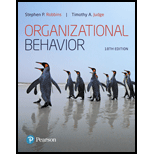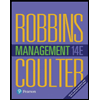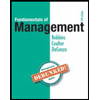
To determine:
Leadership and power are two different positions and responsibilities, this difference will be discussed below.
Introduction:
Leadership is the ability to lead a group of people into achieving an organizations goals, targets and visions. Leaders have the ability to motivate their group members towards achieving team or major goals. Different leaders use different styles of leadership
Power is the ability to make people work towards an objective amd the ability to get the task done is defined as power. This power is something more than the ability to just motivate. There are many kinds of powers and individuals could wield over a group such as positional power, informational power, reward power, coercive power and etc,
A manager in a company could have both factors together, where he is able to lead and have over his subordinates at the same time. However just because someone is a leader doesn’t mean he/she has the power too.
Explanation of Solution
Firstly having power over something and the ability to lead someone is two different scenarios, however these two could come together. The common differences include the following;
Leaders may use their power in achieving their goals however power doesn’t require the motivation of goal accomplishment, power only requires dependence.
Further direction of influence in leadership focuses on downward influence whereas power focuses on all factors considered.
leadership focuses on style such as autocratic, democratic, lazziez fair and paternalistic. While power focuses on tactics.
Leadership focuses on the motivation skills of the employees while power is how to use the skills in order to achieve goals given.
Leadership can be varied as successful leadership and effective leadership. Successful leadership is where when you get a group with a task you boss the group and them do their task day and night and accomplish the goals. Effective leadership is where the leader accomplishes but then brings the team along too through emotional intelligence. Therefore successful leaders more likely use power to ensure goals are met, they use legitimate and coercive power at times. Further effective leaders may also use some powers like referent power but not as much as successful leadership.
Therefore in conclusion leadership and power are two different scenarios because someone who is an leader may not have the power to control his members whereas someone with power may not be a great leader. But successful leaders may use power in leadership.
Want to see more full solutions like this?
Chapter 13 Solutions
Organizational Behavior (18th Edition) (What's New in Management)
- How can managers/leaders of today encourage employee participation in the decision-making process?arrow_forwardCan you guys help me on this? Thank you! Here's the authentic insight my classmate wrote about the article they chose. Please give a little comment on this insight that my classmate just wrote. Thank you!arrow_forwardHi! Can you guys help me with this? Thank you! Here's the article by Mark Chediak & Jennifer A Dlouhy from Bloomberg called US Imposes Tariffs Up to 3,521% on Southeast Asia Solar Imports Please offer authentic insights on how this article connects with global supply chain management.arrow_forward
- How an individual attending a university can help the development of a country?arrow_forwardDiscuss how personal ethical values, such as those held by Jane Harris, and corporate ethical values can influence business decisions at GlobalTech. Provide examples from the scenario where conflicts between personal and corporate ethics versus local business practices arise. - Provides a clear definition of personal and corporate ethical values and their relevance to business decision-making.- Discusses how Jane Harris's belief in ethical universalism influences her decision- making. Examples from the scenario are well integrated. - Explains the role of corporate ethics at GlobalTech, particularly around sustainability, fair wages, and safe working conditions. Discusses how these values shape business policies and practices. - Summarises the influence of personal and corporate values on decision-making and how ethical conflicts may affect a multinational business like GlobalTech. - The discussion is logically structured, with clear argumentation and a coherent flow of ideas.arrow_forwardYou will explain what it is, Benefits, Threats, and Ethical Challenges.arrow_forward
- Explore strategies entrepreneurs and business leaders can use to balance ethical relativism and universal ethical principles when operating across diverse cultural landscapes, as illustrated by GlobalTech’s expansion into a developingcountry. -Provides a clear explanation of ethical relativism and universal ethical principles and why they are important in cross-cultural business operations. - Identifies and thoroughly explains at least three strategies to balance these ethical approaches. Application of examples from the scenario is key, especially in balancing cost savings with ethical standards. - Examines the challenges faced by GlobalTech and similar businesses in aligning local practices with global ethicalstandards, highlighting possible outcomes of choosing one ethical stance over another.arrow_forwardtesla ebike new extended brand content: conclusion?arrow_forwardcontent:Overview of Apple Health as a Brand Extension?arrow_forward
- I am designing a Management by Objectives (MBO) performance appraisal for the Training and Development Specialist position to be used I meet with the incumbent employee to explain your expectations for their performance over the next twelve months. I need 3 objectives that the employee will be evaluated on. Be sure to include the time line by which each goal will be met, as well as dates for review of accomplishments.arrow_forwardTerminating an employee is often one of the most stressful, and in some cases, fearful decisions managers are required to take. After you read and understand the four bases (reasons) for terminating an employee on page 324 of your textbook you are to develop a short scenario as to why you have chosen an employee to be terminated. Following the scenario you are to prepare a step-by-step process for meeting with the employee being terminated. The process should be direct, without too much information that will cause a potential argument, but with enough information that provides background and future steps (last day of work, summary of benefits, if any, and expectations regarding employee behavior if the employee is returning to their work area until the actual termination date, rarely if ever the termination is due to insubordination). It should be assumed that you will have a fellow supervisor/manager or an HR professional in the termination discussion (terminations should never be…arrow_forwarduk unileaver stock exchange london , content: "abstruct"?arrow_forward
 Understanding BusinessManagementISBN:9781259929434Author:William NickelsPublisher:McGraw-Hill Education
Understanding BusinessManagementISBN:9781259929434Author:William NickelsPublisher:McGraw-Hill Education Management (14th Edition)ManagementISBN:9780134527604Author:Stephen P. Robbins, Mary A. CoulterPublisher:PEARSON
Management (14th Edition)ManagementISBN:9780134527604Author:Stephen P. Robbins, Mary A. CoulterPublisher:PEARSON Spreadsheet Modeling & Decision Analysis: A Pract...ManagementISBN:9781305947412Author:Cliff RagsdalePublisher:Cengage Learning
Spreadsheet Modeling & Decision Analysis: A Pract...ManagementISBN:9781305947412Author:Cliff RagsdalePublisher:Cengage Learning Management Information Systems: Managing The Digi...ManagementISBN:9780135191798Author:Kenneth C. Laudon, Jane P. LaudonPublisher:PEARSON
Management Information Systems: Managing The Digi...ManagementISBN:9780135191798Author:Kenneth C. Laudon, Jane P. LaudonPublisher:PEARSON Business Essentials (12th Edition) (What's New in...ManagementISBN:9780134728391Author:Ronald J. Ebert, Ricky W. GriffinPublisher:PEARSON
Business Essentials (12th Edition) (What's New in...ManagementISBN:9780134728391Author:Ronald J. Ebert, Ricky W. GriffinPublisher:PEARSON Fundamentals of Management (10th Edition)ManagementISBN:9780134237473Author:Stephen P. Robbins, Mary A. Coulter, David A. De CenzoPublisher:PEARSON
Fundamentals of Management (10th Edition)ManagementISBN:9780134237473Author:Stephen P. Robbins, Mary A. Coulter, David A. De CenzoPublisher:PEARSON





